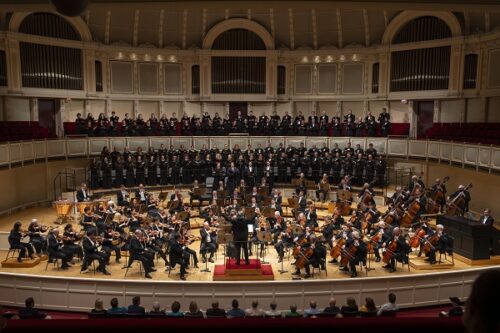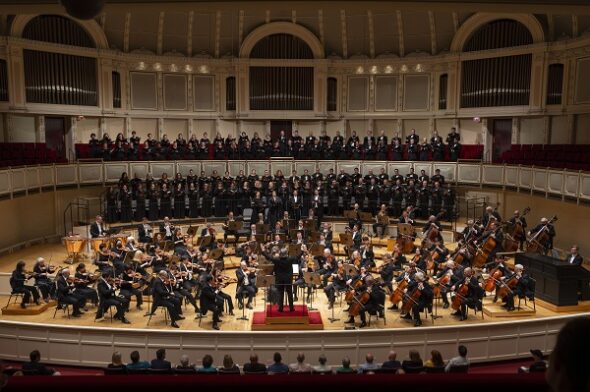 United States Beethoven: Erin Morley (soprano), Alisa Kolosova (mezzo-soprano), Giovanni Sala (tenor), Kyle Ketelsen (bass-baritone), Chicago Symphony Chorus and Orchestra / Riccardo Muti (conductor). Symphony Center, Chicago, 23.6.2023. (JLZ)
United States Beethoven: Erin Morley (soprano), Alisa Kolosova (mezzo-soprano), Giovanni Sala (tenor), Kyle Ketelsen (bass-baritone), Chicago Symphony Chorus and Orchestra / Riccardo Muti (conductor). Symphony Center, Chicago, 23.6.2023. (JLZ)

Beethoven – Missa solemnis in D major, Op.123
Riccardo Muti and the Chicago Symphony Orchestra brought the 2022–2023 season to a splendid conclusion with three performances of Beethoven’s Missa solemnis that featured international soloists and the Chicago Symphony Chorus. The staging involved a thoughtful placement of the singers, with the chorus in the seating area at the back of the stage and on risers behind the orchestra. The soloists were on a riser in front of the chorus so that they sang with the group rather than in front of the orchestra. This effective arrangement reinforced the interactions between solo voices and the chorus.
Mezzo-soprano Alisa Kolosova was particularly strong, especially in duet with tenor Giovanni Sala in the Kyrie, as well as passages with soprano Erin Morley in the ‘Gratias agimus tibi’ section of the Gloria. Morley gave a fine performance in the demanding part that Beethoven assigned to the solo soprano, and the other soloists were similarly notable. In the ‘Et homo factus est’ passage of the Credo it was possible to hear Sala’s warm tenor quite well. Yet the most impressive soloist remains Kyle Ketelsen for a full, persuasive voice that resounded when required and blended with other soloists or, later, with the chorus in the Agnus Dei. It is rare to find such well-matched solo voices, and it was rewarding in this festival-like performance.

Likewise, the Chicago Symphony Chorus gave a strong reading of the challenging score, and credit for its preparation belongs to guest chorus director Donald Palumbo. In this generally extroverted work, the nuances of the choral forces contributed to Muti’s interpretation of the piece. The opening of the Gloria was notable for the fine diction that rendered each word distinctly, and this approach was effective in the ‘Et incarnatus est’ section of the Credo. At times, though, the density of the text and the full scoring for instruments made some passages, like the opening of the Credo, less clear. Nevertheless, the shifts between soloists and choral forces near the end of the Credo gave the movement a satisfying resolution.
The Chicago Symphony Orchestra was impressive for the subtle shadings and distinct timbres it offered. The low strings were resonant and articulate throughout and supported the upper string sonorities solidly. Concertmaster Robert Chen’s solo passages in the Sanctus were particularly moving. All the forces came together with masterful skill in the Agnus Dei to reinforce the prayer for peace that Beethoven brought out in this work. Here, the solo voices, chorus, solo instruments and full orchestra need to deploy with consummate skill, and Muti commanded the stage in this movement as he brought the work to a powerful conclusion. It was a suitable way for Muti to culminate his years as music director of the CSO.
In his status as conductor emeritus, Muti will continue his association with the CSO in the next two seasons, including leading the orchestra on its planned 2024 European tour.
James L. Zychowicz
